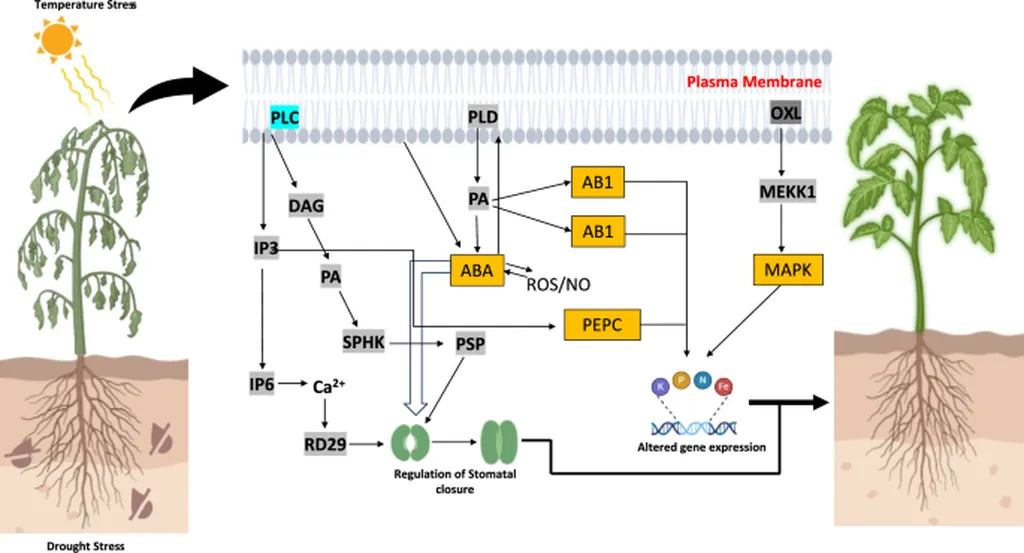In the quest to optimize crop yields, scientists have long sought to understand the intricate processes governing leaf senescence, the natural aging process that ultimately determines nutrient remobilization and, consequently, crop productivity. A recent study published in *Scientia Horticulturae* has shed new light on this complex phenomenon, with significant implications for the agriculture sector, particularly for rapeseed (Brassica napus), a globally important oilseed crop.
The research, led by Juan Ling of the Guangzhou Key Laboratory for Research and Development of Crop Germplasm Resources and the National Research Centre of Rapeseed Engineering and Technology, focuses on the role of lipid signaling in leaf senescence. Specifically, the team investigated the acyl-CoA-binding protein BnACBP1-like, a protein known to play a crucial role in lipid metabolism.
The study found that the upregulation of BnACBP1-like induced premature leaf senescence, characterized by chlorophyll degradation, increased ion leakage, and a significant accumulation of jasmonic acid (JA). Other phytohormones showed no significant differences, indicating that the observed effects were specific to the JA pathway. In contrast, CRISPR/Cas9 knockout lines of BnACBP1-like resembled wild-type plants, suggesting that the protein’s presence is indeed driving the senescence process.
To understand the underlying mechanisms, the researchers employed an integrated multi-omics approach, combining transcriptomics, metabolomics, and proteomics. This comprehensive analysis revealed that BnACBP1-like overexpression triggered extensive lipid remodeling. Specifically, the levels of glycerophospholipids, including phosphatidic acid, phosphatidylcholine, and phosphatidylethanolamine, decreased, while lysophospholipid levels, such as lysophosphatidylcholine and lysophosphatidylethanolamine, along with free fatty acids (FFAs), increased.
Transcriptome profiling further showed the upregulation of lipoxygenases (LOX3, LOX3-like, LOX4, and LOX5) and phospholipase A2β (PLA2β), enzymes known to contribute to JA biosynthesis. Protein interaction assays confirmed a direct binding between BnACBP1-like and PLA2β. Moreover, pharmacological inhibition of PLA2β activity suppressed senescence, suggesting that the interaction between these two proteins promotes phospholipid hydrolysis and the release of FFA substrates for JA synthesis.
“This study reveals a critical role for lipid signaling in leaf senescence and elucidates the molecular mechanism by which BnACBP1-like regulates lipid metabolism,” said Juan Ling. “Understanding these processes offers potential strategies to enhance photosynthetic product reutilization by controlling leaf senescence.”
The commercial implications of this research are substantial. By manipulating the expression of BnACBP1-like and its interaction with PLA2β, farmers and agritech companies could potentially extend the photosynthetic period of rapeseed crops, thereby increasing yield and optimizing nutrient remobilization. This could lead to more efficient crop management practices and improved economic returns for growers.
Furthermore, the insights gained from this study could have broader applications beyond rapeseed. As Juan Ling explained, “The mechanisms we’ve uncovered are likely conserved across plant species, making this research relevant to a wide range of crops.”
Looking ahead, this research paves the way for further investigations into the role of lipid signaling in plant development and stress responses. By continuing to unravel these complex biological processes, scientists can develop innovative strategies to enhance crop productivity and sustainability in an ever-changing agricultural landscape.
The study, titled “BnACBP1-like in regulating JA-dependent leaf senescence via lipid remodeling and interaction with PLA2β in Brassica napus,” was published in *Scientia Horticulturae* and represents a significant advancement in our understanding of leaf senescence and lipid signaling in plants.

